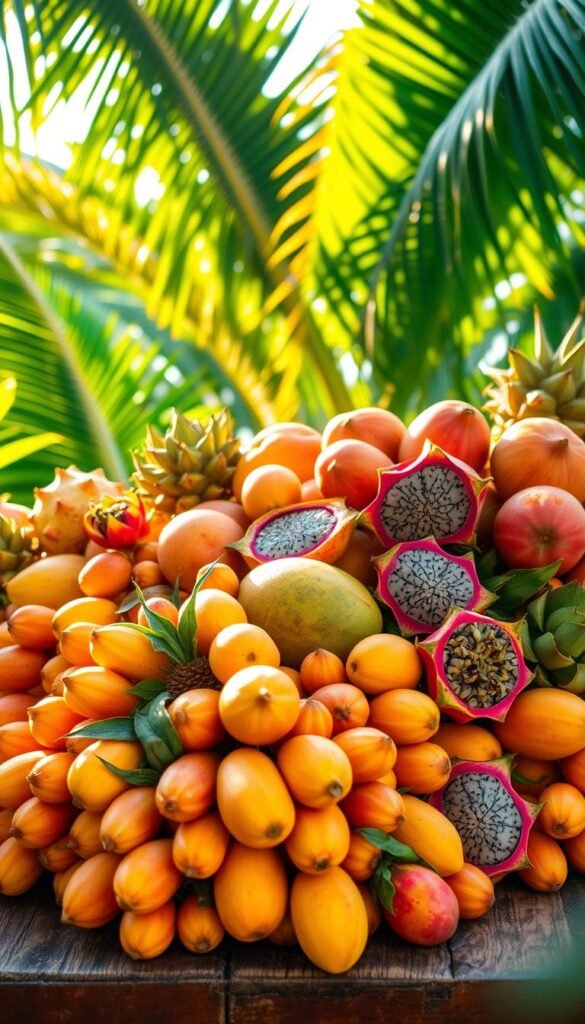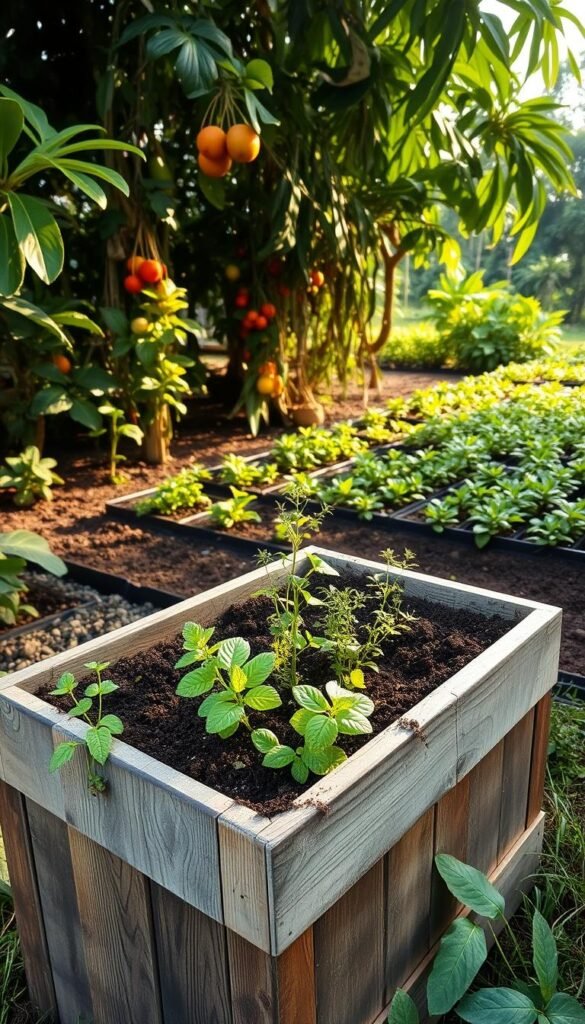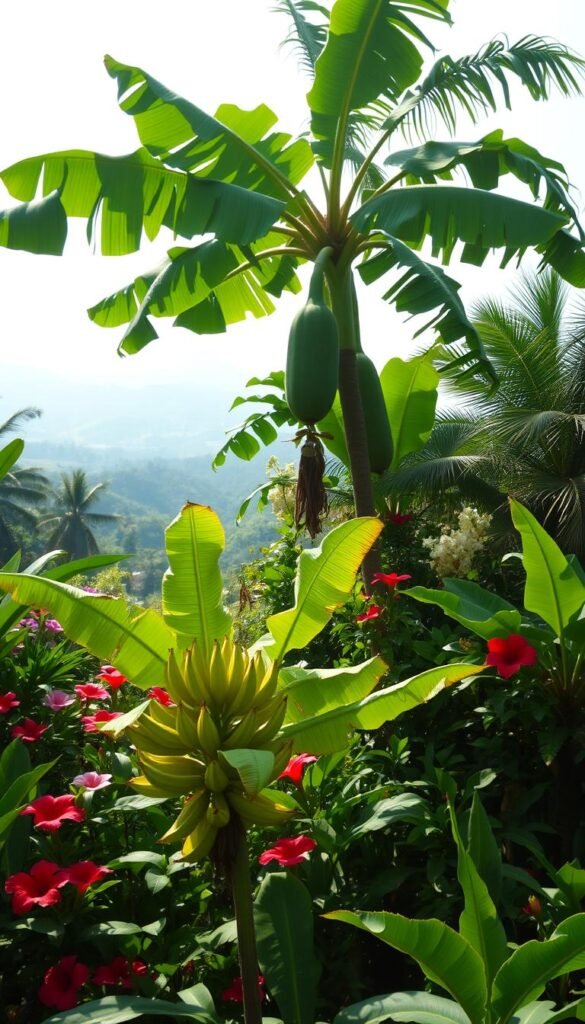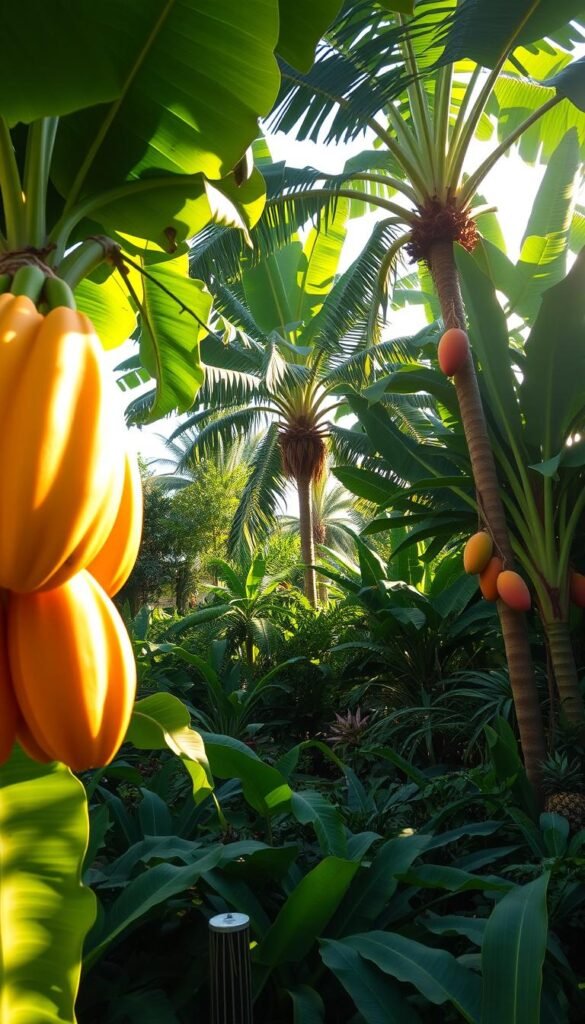Imagine plucking juicy, sun-ripened treats from plants thriving in your living room or patio. You don’t need a Hawaiian climate to enjoy fresh, exotic flavors year-round. With smart container gardening, even chilly regions like western Massachusetts can become hubs for vibrant, edible greenery.
This approach lets you control temperatures and sunlight, creating perfect conditions for delicate species. Whether you’re in USDA zone 5 or 10, citrus trees and sweet tropical varieties adapt surprisingly well to indoor spaces. Many enthusiasts successfully grow dwarf mangoes and compact banana plants that produce actual harvests.
You’ll find modern techniques make it easier than ever to nurture these plants. From self-watering pots to specialized fertilizers, every challenge has a practical solution. The real magic happens when you taste your first home-harvested pineapple or lemon – flavors that outshine anything store-bought.
We’ll show you how to select cold-hardy varieties and master essential care routines. Discover space-saving strategies for apartments and creative ways to use grow lights. Your journey to a personalized edible oasis starts here, no matter what the thermometer says outside.
Discovering the Essentials of a Tropical Fruit Garden

Unlock the secrets to cultivating vibrant, sweet treasures in any living space. Over 50 edible species adapt well to containers, from zesty citrus to juicy mangoes. You’ll find options for every skill level and space constraint – even a windowsill can host a pineapple plant started from grocery store scraps.
Tailoring Plants to Your Environment
Dwarf citrus trees and compact banana varieties thrive indoors with 6+ hours of sunlight. Meyer lemons and kumquats are low-maintenance champions, while dragon fruit vines add vertical interest. Consider these factors when choosing:
- Container size (15-25 gallon pots for most trees)
- Daily light requirements (full sun vs partial shade)
- Humidity preferences (60-80% ideal for many species)
Rewards Versus Realities
Homegrown produce offers unmatched flavor – imagine lime juice that’s actually tart or mango flesh bursting with sweetness. You’ll save money long-term (a $30 tree yields $100+ worth of fruit annually). But be prepared for:
- 3-5 year waits for some trees to bear harvests
- Seasonal leaf drop as plants adjust to indoor climates
- Pest management in controlled environments
Success comes from matching species to your conditions. South-facing rooms work for light-loving guavas, while lychees need consistent moisture. Start with forgiving varieties like calamondin oranges before tackling fussier specimens.
Preparing Your Garden Space: Soil, Watering, and Fertilization

Your success with exotic edibles hinges on three pillars: smart soil choices, precise hydration, and balanced nutrition. Let’s break down how to build these foundations effectively.
Selecting the Right Soil, Containers, and Fertilization Techniques
Start with a soil mix that breathes while holding moisture. Combine coconut coir, perlite, and compost for a blend that prevents soggy roots. Drainage holes in containers are non-negotiable – clay pots work wonders for species needing drier conditions.
When choosing containers, consider both depth and mobility. A 15-gallon fabric grow bag suits citrus trees, while dwarf varieties thrive in smaller homes. For container gardening basics, prioritize lightweight options if you’ll move plants seasonally.
Fertilization follows a golden rule: feed heavily during active growth (spring-summer) and ease off in winter. Use slow-release pellets for steady nutrition, supplementing with liquid seaweed every 2-4 weeks.
Creating an Optimal Climate: Sunlight, Humidity, and Temperature Tips
South-facing windows become your best friend, offering 6+ hours of daily light. Rotate plants weekly for even exposure. Can’t provide enough natural sun? Full-spectrum LED grow lights fill the gap beautifully.
Maintain temperatures above 60°F – heating mats help during chilly nights. Boost humidity with pebble trays or room humidifiers, especially for moisture-loving varieties. Let the top inch of soil dry between waterings for most species, but keep moisture consistent for plants like ginger.
Watch for leaf clues: yellowing often signals overwatering, while crispy edges beg for higher humidity. Adjust your care routine with the seasons, and your green companions will reward you with vigorous growth.
Tropical Fruit Garden Guide: Growing Bananas, Papayas, and More

Turn your patio into a productive paradise with these sun-loving superstars. While each species has unique needs, smart growers focus on three essentials: light management, soil chemistry, and strategic pruning. Let’s explore how to maximize yields from popular favorites.
Growing Bananas: Best Practices and Container Strategies
Banana plants thrive when treated like royalty – give them 8+ hours of daily sun and rich, crumbly earth. Mix compost into potting soil for steady nutrition, and water when the top inch feels dry. “Container-grown specimens often outproduce ground plants when given proper potassium supplements,” notes urban farming expert Lisa Nguyen.
Remove suckers monthly to direct energy toward fruiting. Use 25-gallon pots with drainage holes, and wrap stems in winter if temperatures dip below 50°F. Most dwarf varieties bear sweet clusters within 18 months under ideal conditions.
Cultivating Papayas and Other Tropical Delights
Papayas demand full sunshine and weekly feeding during growth spurts. Young trees in 15-gallon containers produce oval fruits within a year – harvest when skins yellow slightly. Rotate plants weekly for even ripening, and replace trees every 2-3 years for peak productivity.
For mango lovers, grafted trees in half-wine barrels yield fruits faster than seed-grown plants. Pineapple enthusiasts should start with crown cuttings in sandy soil, patiently waiting 24-36 months for golden rewards. Always monitor for common pests like spider mites, using neem oil sprays at first sign of trouble.
Pair these techniques with seasonal fertilizer adjustments, and you’ll enjoy nature’s candy straight from your home setup. Remember – consistency matters more than perfection when nurturing these warm-weather wonders.
Wrapping Up Your Tropical Garden Journey with Expert Advice
Your journey into cultivating exotic flavors at home becomes rewarding with smart planning. Even compact varieties like the Glen mango may reach 10 feet, but strategic container sizing keeps them manageable. Those in chillier regions will appreciate how full-spectrum grow lights compensate for limited winter sunlight.
Build confidence through seasonal routines – rotate fertilizer types as plants mature, and refresh soil annually. Connect with local gardening groups to swap cuttings and troubleshoot pests. Many enthusiasts share propagation tips for extending your collection without extra costs.
Celebrate each milestone, whether it’s your first ripe papaya or a thriving lemon tree. Remember, patience pays: some specimens take years to fruit but deliver unmatched sweetness. Stay curious about new varieties that suit your space, and soon you’ll enjoy a rotating harvest of juicy mangoes, creamy bananas, and zesty citrus.
The real magic lies in savoring sun-warmed flavors picked minutes before eating. With these insights, you’re ready to nurture delicious success – no passport required.






